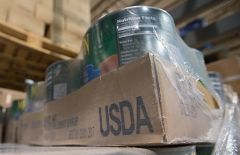SNAP Beneficiaries May Get More Food in a Box, Less Cash on a Card

It is finished!
February 14, 2018
Defending Humanae Vitae: A Bishop Stands Up for the Truth (Video)
February 14, 2018
By Susan Jones, CNSNews, February 14, 2018
 The Trump administration’s Fiscal Year 2019 budget envisions major changes to the nation’s food stamp program, or SNAP.
The Trump administration’s Fiscal Year 2019 budget envisions major changes to the nation’s food stamp program, or SNAP.Instead of just cash, some of the benefits will be actual food items, grown in the USA.White House Budget Director Mick Mulvaney told reporters on Tuesday that the idea for the Food Box Program originated at the U.S. Agriculture Department.
We thought it was a tremendous idea so what we do is propose that, for folks who are on food stamps — part, not all — part of their benefits come in the actually sort of — and I don’t want to steal somebody’s copyright — but a Blue Apron-type program where you actually receive the food instead of receive the cash.
It lowers the cost to us because we can buy prices at wholesale, whereas they have to buy it at retail. It also makes sure that they’re getting nutritious food. So we’re pretty excited about that. That’s a tremendous cost savings.
 Mulvaney said SNAP is among the welfare programs that will require able-bodied food stamp recipients to work or at least look for a job.
Mulvaney said SNAP is among the welfare programs that will require able-bodied food stamp recipients to work or at least look for a job.
What will be in the food box? a reporter asked Mulvaney: And will the food be delivered by the U.S. postal service?
“Yeah, I don’t know about the Postal Service question,” Mulvaney replied. Prodded by an aide, he said the food “goes to the individual state.”
“As to the actual food box program, I think we’re using the current program for seniors as a model.”
The Commodity Supplemental Food Program aims to improve the health of low-income elderly people, at least 60 years of age, by giving them boxes of nutritious USDA foods.
Food packages for these seniors include a variety of foods, such as nonfat dry and ultra-pasteurized fluid milk, juice, farina, oats, ready-to-eat cereal, rice, pasta, peanut butter, dry beans, canned meat, poultry, or fish, and canned fruits and vegetables.
State agencies that administer CSFP typically include departments of health, social services, education, or agriculture. State agencies store CSFP food and distribute it to public and nonprofit private local agencies. Local agencies determine the eligibility of applicants, distribute the foods, and provide nutrition education.
Mulvaney said the Trump administration will get rid of the CSFP program for seniors: “Been doing it for a long time, right?” Muvaney said. “And that’s not because we’re not going to feed the seniors food. All we’re doing is folding those folks into the Food Box Program. So we’re going from a food stamp — a SNAP program and a food box for seniors, and we’re putting everybody together in one program.
“But what I’ve been told from USDA, it’s 100 percent domestically grown food. And it has been pitched as being more nutritious than what may otherwise be.
Please support CNSNews today! (a 501c3 non-profit production of the Media Research Center)




